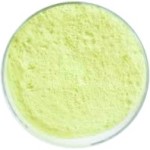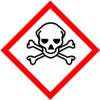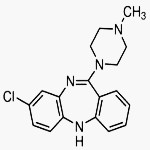CAS Number 5786-21-0, Clozapine IP USP BP Ph Eur Grade Manufacturers Exporters







CAS Number 5786-21-0, Clozapine IP USP BP Ph Eur Manufacturer Exporter
For Properties Specifications of Clozapine Click Properties, Specifications of Clozapine Manufacturer.
For Uses of Clozapine Click Uses of Clozapine Manufacturer.
For For SDS MSDS Sheet of Clozapine Click SDS Safety Data Sheet MSDS Sheet of Clozapine Manufacturer.
The Properties and Specifications of Clozapine:
Clozapine BP Ph Eur Grade Specifications
Ph. Eur.
C18H19ClN4 --- 326.8 --- 5786-21-0
Action and use: Dopamine D4 receptor antagonist; neuroleptic.
DEFINITION
8-Chloro-11-(4-methylpiperazin-1-yl)-5H-dibenzo[b,e][1,4]diazepine.
Content: 99.0 per cent to 101.0 per cent (dried substance).
CHARACTERS
Appearance: Yellow, crystalline powder.
Solubility: Practically insoluble in water, freely soluble in methylene chloride, soluble in ethanol (96 per cent). It dissolves in dilute acetic acid.
IDENTIFICATION
A. Melting point: 182C to 186C.
B. Infrared absorption spectrophotometry.
TESTS
Related substances: To pass the test by liquid chromatography.
Loss on drying: Maximum 0.5 per cent, determined on 1.000 g by drying in an oven at 105C.
Sulfated ash: Maximum 0.1 per cent, determined on 1.0 g.
ASSAY
Dissolve 0.100 g in 50 mL of anhydrous acetic acid. Titrate with 0.1 M perchloric acid, determining the end-point potentiometrically. 1 mL of 0.1 M perchloric acid is equivalent to 16.34 mg of C18H19ClN4.
IMPURITIES
Specified impurities A, B, C, D
A. 8-chloro-5,10-dihydro-11H-dibenzo[b,e][1,4]diazepin-11-one,
B. 11,11′-(piperazine-1,4-diyl)bis(8-chloro-5H-dibenzo[b,e][1,4]diazepine),
C. 8-chloro-11-(piperazin-1-yl)-5H-dibenzo[b,e][1,4]diazepine,
D. 1-[2-[(2-amino-4-chlorophenyl)amino]benzoyl]-4-methylpiperazine.
Clozapine USP Grade Specifications
C18H19ClN4 --- 326.83
5H-Dibenzo[b,e][1,4]diazepine, 8-chloro-11-(4-methyl-1-piperazinyl)-.
8-Chloro-11-(4-methyl-1-piperazinyl)-5H-dibenzo[b,e][1,4]diazepine CAS 5786-21-0
Clozapine contains not less than 98.0 percent and not more than 102.0 percent of C18H19ClN4, calculated on the dried basis.
Packaging and storage: Preserve in well-closed containers.
Identification:
A: Infrared Absorption.
B: The RF value of the principal spot observed in the chromatogram of the Test solution corresponds to those of the principal spots observed in the chromatograms of the Standard solutions, as obtained in the test for Chromatographic purity.
Melting range: between 182C and 186C.
Loss on drying: Dry it at 105C for 4 hours: it loses not more than 0.5% of its weight.
Residue on ignition: not more than 0.1%.
Heavy metals: 0.002%.
Chromatographic purity: To pass the test.
Assay: Transfer about 115 mg of Clozapine, accurately weighed, to a suitable container, dissolve in 70 mL of glacial acetic acid, and titrate with 0.1 N perchloric acid, determining the endpoint potentiometrically. Perform a blank determination, and make any necessary correction. Each mL of 0.1 N perchloric acid is equivalent to 16.34 mg of C18H19ClN4.
We also manufacture Clozapine IP Grade
The Uses of Clozapine:
Clozapine is a typical antipsychotic medication apart from other uses. It is mainly used for schizophrenia that does not improve following the use of other antipsychotic medications.
The MSDS-SDS Hazard Statement of Clozapine:
Clozapine SDS, Safety Data Sheet
MSDS Sheet, Material Safety Data Sheet 16-Nov-24
1. Product Identification
Product Name & Other Names: Clozapine.
CAS Number: 5786-21-0
EINECS EC Number: 227-313-7
Intended Use: Industrial Manufacturing.
Relevant uses and uses advised against (if any): Industrial Manufacturing.
Suppliers: As per letterhead.
2. Hazards Identification
GHS, Globally Harmonized System Classification in accordance with 29 CFR 1910
Classification according to Regulation (EC) No 1272/2008
Acute toxicity, Oral: Category 3, H301
Specific target organ toxicity, single exposure; Narcotic effects Category 3, H336
Germ cell mutagenicity Category 2, H341
Reproductive toxicity Category 2, H361
Labeling according to GHS USA & Regulation (EC) No 1272/2008
GHS Label Elements  Toxic |
GHS Label Elements |
Signal Words: Danger
Hazard Statements:
H301: Toxic if swallowed.
H341: Suspected of causing genetic defects.
H336: May cause drowsiness and dizziness.
H361: Suspected of damaging fertility or the unborn child.
Precautionary Statements:
P202: Do not handle until all safety precautions have been read and understood.
P260: Do not breathe dust/fume/gas/mist/vapors/spray.
P262: Do not get in eyes, on skin, or on clothing.
P270: Do not eat, drink or smoke when using this product.
P280: Wear protective gloves/protective clothing/eye protection/face protection.
P301+P310: IF SWALLOWED: Immediately call a POSION CENTER or doctor/physician.
P302+352: IF ON SKIN: Wash with plenty of soap and water.
P305+351+338: IF IN EYES: Rinse cautiously with water for several minutes. Remove contact lenses if present and easy to do – continue rinsing.
3. Composition/Information on Ingredients
Product Name & Other Names: Clozapine.
CAS Number: 5786-21-0
EINECS EC Number: 227-313-7
4. First Aid Measures
Inhalation: Remove affected person to fresh air; if normal breathing has not returned within a few minutes after exposure, get medical attention.
Skin: Remove contaminated clothing; wash affected area with soap and water; launder contaminated clothing before reuse. Seek medical attention.
Eyes: Immediately, flush eyes for 15 minutes in clear running water while holding eyelids open; seek medical attention immediately.
Ingestion: Drink two glasses of water followed by milk, milk of magnesia or other non-alcoholic liquids; Do not induce vomiting; seek medical attention immediately.
5. Fire Fighting Measures
Flammable Limits: No unusual fire or explosion hazards noted.
General Hazards: Contact with eyes causes immediate severe irritation of the eye and eyelids.
Extinguishing Media: Carbon dioxide, water fog, dry chemical, chemical foam.
Organics solids, may be ignitable. Keep containers cool by spraying with water. Use extinguishing media appropriate for surrounding fire. Avoid solid water jet as it can scatter the fire.
Fire & Explosion Hazard: May evolve toxic fumes, oxides of carbon (COx), oxides of nitrogen (NOx) under fire conditions.
In case of fire, wear a full face positive-pressure self-contained breathing apparatus and protective suit. Self - contained respiratory equipment; cool containers to prevent pressure buildup and possible explosion when exposed to extreme heat.
Hazardous Combustion Products: Products of combustion include smoke, toxic fumes, oxides of carbon to include carbon monoxide, nitrogen oxides, hydrogen chloride.
Specific Methods: Cool containers exposed to flames with water until well after the fire is out.
Special Information: In the event of a fire, wear full protective clothing and NIOSH-approved self-contained breathing apparatus with full face piece operated in the pressure demand or other positive pressure mode.
6. Accidental Release Measures
Personal precautions, protective equipment, and emergency procedures: It may support combustion. Do not touch damaged containers or spilled material unless wearing appropriate protective clothing. Avoid breathing dust/fumes/gas/mist/vapors/spray. Use individual protective equipment (waterproof boots, suitable protective clothing, safety glasses, etc.).
Environmental precautions: Do not let the product enter drains, soil, or water sources.
Methods and materials used for containment Cleanup procedures and Storage: Contain spilled material. Cover with an inert, non-combustible absorbent material, (e.g. sand, earth, diatomaceous earth, vermiculite). Vacuum or sweep-up and remove to an approved disposal container.
7. Handling and Storage
Precautions for safe handling: Apply according to good manufacturing and industrial hygiene practices. Ensure proper ventilation. Wash thoroughly after handling. Do not drink, eat, or smoke while handling. Avoid contact with skin, eyes, and clothing. Minimize dust generation. Avoid breathing dust/fumes/gas/mist/vapors/spray. Provide appropriate exhaust ventilation at places where dust is formed. Keep container tightly closed. Avoid ingestion and inhalation. Use individual protective equipment (waterproof boots, suitable protective clothing, safety glasses, etc.).
Conditions for safe storage, including any incompatibilities: Store in cool, dry, and ventilated area away from heat sources and protected from sunlight in tightly closed original container. Keep air contact to a minimum. Do not leave the material container open. Store protected from heat, sparks and ignition sources and incompatible materials. Avoid inhalation of dust/mist/vapor. Do not store with incompatible materials like strong bases & oxidizing agent. Keep this and other chemicals out of reach of children.
8. Exposure Controls/Personal Protection
Engineering Controls: The use of local exhaust ventilation is recommended to control emissions near the source. Provide mechanical ventilation of confined spaces.
Exposure Limits: Not established.
Ventilation System: A system of local and/or general exhaust is recommended to keep employee exposures as low as possible.
Personal Respirators (NIOSH Approved): For conditions of use where exposure to dust or mist is apparent and engineering controls are not feasible, a particulate respirator may be worn.
Skin Protection: Wear protective gloves and clean body-covering clothing.
Eye Protection: Use chemical safety goggles and/or full face shield where dusting or splashing of solutions is possible. Maintain eye wash fountain and quick-drench facilities in work area.
Other Control Measures: Maintain good housekeeping in work area. Handle in accordance with good industrial hygiene and safety practice. Wash hands after handling.
9. Physical and Chemical Properties
Appearance: Yellow, crystalline powder.
Odor: No data found.
Odor threshold: No data found.
pH: No data found.
Relative density: No data found.
Melting/Freezing Point: 182C to 186C.
Initial boiling point and boiling range: No data found.
Flash point: No data found.
Auto-ignition temperature: No data found.
Decomposition temperature: No data found.
Upper/lower flammability or explosive limits: No data found.
Vapor pressure: No data found.
Vapor density: No data found.
Evaporation rate: No data found.
Flammability (solid, gas): No data found.
Partition coefficient: n-octanol/water: No data found.
Solubility in Water: Negligible.
Viscosity: No data found.
10. Stability and Reactivity
Stability: Stable at normal temperatures and operating conditions.
Conditions to Avoid: Avoid excessively high temperatures and contact with alkalis or strong oxidizing agents.
Incompatibilities: Strong Bases & Oxidizing Agent.
Decomposition: Decomposition yields toxic fumes, oxides of carbon (COx), oxides of nitrogen (NOx), hydrogen chloride.
Polymerization: Polymerization will not occur.
11. Toxicological Information
Toxicity Data:
LD50 Oral - Rat - 251 mg/kg
LD50 Subcutaneous - Rat - 240 mg/kg
LD50 Intramuscular - Rat - 210 mg/kg
LD50 Intravenous - Rat - 41,6 mg/kg.
Reproduction: Suspected human reproductive toxicant.
Mutagenicity: Investigated as a drug, mutagen, and reproductive effector.
Carcinogenicity: Not listed as a human carcinogen by OSHA, IARC, ACGIH & NTP.
Remarks on Possible Effects: Dizziness. Fainting. Fever. Weight gain. Anxiety. Irritability. Restlessness. Confusion. Blurred vision. Tremor. Headache. Constipation. Drowsiness. Salivation. Nausea. Vomiting. Heartburn. Sweating. Nervousness. Hallucinations. Seizures. Narcotic effects.
12. Ecological Information
Toxicity to fish: No data found.
Results of PBT and vPvB assessment: No data found.
Persistence and degradability: No data found.
Bioaccumulative potential: No data found.
Mobility: No data found.
13. Disposal Considerations
Dispose of in accordance with Local, State, and Federal Regulations. Follow all the pollution control laws.
14. Transport Information
DOT USA & ADR/RID Europe
Proper Shipping Name: TOXIC SOLID, ORGANIC, N.O.S. (CLOZAPINE)
UN#: 2811
Class: 6.1; Packing Group: Packing Group III
IATA & IMDG
Proper Shipping Name: TOXIC SOLID, ORGANIC, N.O.S. (CLOZAPINE)
UN#: 2811
Class: 6.1; Packing Group: Packing Group III
15. Regulatory Information
No significant information is available.
Section 16 - Additional Information
Disclaimer:
**************************
Our company provides this MSDS sheet in good faith but makes no representation as to its comprehensiveness or accuracy. This SDS sheet is intended only as a guide to the appropriate precautionary handling of the material by a properly trained person using this product. The above information has been compiled from various sources and has the possibility of discrepancy and being out-dated information. Individuals receiving the information must exercise their independent judgment and do further search in determining its appropriateness for a particular purpose. In no case shall our company be liable to loss or damages by the product user.
**************************
Anmol Chemicals & Pharmaceuticals Pvt. Ltd. is an off-shoot of Anmol Chemicals Taloja. It is located in MIDC Taloja and it is manufacturing pharmaceutical grades of API, Excepients, Food grade and Reagent grade chemicals. Anmol Chemicals & Pharmaceuticals Pvt. Ltd. is a several decades old group of companies, engaged in manufacturing, supplying, distributing, wholesale supplies for actual users, retail or small pack supplies for research and development chemicals, fine and speciality chemicals, pharmaceutical excipients, mineral fortifiers in chemically pure, Analytical reagent grade, IP BP USP Ph Eur EP JP and other pharmaceutical grade monograph including FCC Food grade chemicals and Nutraceuticals, Mineral Fortifiers at best prices.

Clozapine Structure
CAS Number 5786-21-0, Clozapine Manufacturer Exporter
ANMOL CHEMICALS & PHARMACEUTICALS Pvt. Ltd.
India, USA, Europe, UAE
TELEPHONE: +912223770100
Navi Mumbai, INDIA
e-mail: info(At the rate i.e. @)anmol.org
Copyright. 11-dec-24
We manufacture:


